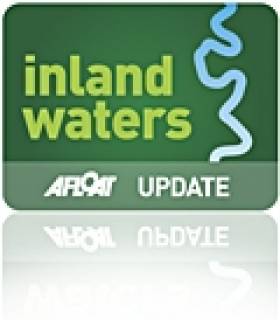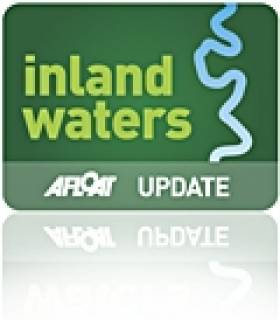Displaying items by tag: Barrow River
#barrowblueway – Waterways Ireland in partnership with Carlow, Kilkenny, Kildare and Laois County Councils and LEADER Companies is proposing to develop a Barrow Blueway, a 112km long shared-use trail for local people and visitors to enjoy along the route of the Barrow Way-Marked Way.
Following on from a number of studies and reports commissioned by various authorities including Waterways Ireland, the Local Authorities, LEADER Partnership Companies and Fáilte Ireland a series of interventions and programmes have been agreed and are being implemented by the agencies both collectively and individually. One such initiative is the Barrow Blueway.
The Barrow River and Barrow Line of the Grand Canal are waterway corridors of National and International importance and spectacular recreation and leisure amenities. Both the river and canal support a myriad of sustainable activities and sustain a rich and diverse built and natural heritage. It is the intention of Waterways Ireland to develop the existing trackway along the Barrow Line of the Grand Canal and Barrow River as a 112km Blueway. The Blueway would support a myriad of recreation activities, help grow and develop business along the length of the Barrow Blueway. The proposal entails the upgrading of the existing trackway to allow a multi use shared leisure route connecting Lowtown in Co. Kildare to St. Mullins in Co. Carlow, travelling through Lowtown, Rathangan, Monasterevin, Athy, Carlow, Leighlinbridge, Bagenalstown, Goresbridge, Graiguenamanagh and St Mullins.
Éanna Rowe, Head of Marketing & Communications, Waterways Ireland confirmed "Waterways Ireland is delighted to have progressed the Barrow Blueway proposal to the point where we now have meaningful information to share. We look forward to the Public Information Evenings where local businesses, activity providers, clubs, associations and all interested parties can come and view the proposals, examine design options and engage with our staff. We welcome all feedback and indeed will consider it as plans are finalised for this exciting new recreation and tourism initiative. "
The project is currently at design stage with tailored surface finishes to be employed to ensure a durable and fit for purpose trail in accordance with National Trails Office Guidance. This surfacing will not only improve accessibility but provide a more robust surface that will be able to better withstand footfall and traffic. Whilst it is proposed to employ a compacted stone and dust surface, a reinforced grass solution may be used in sensitive locations as guided by environmental requirements to preserve the grassy surface so valued by many people.
Carlow County Council Spokesman stated " In the context of progressing the economic and social development of the county, Carlow County Council is open to exploring and considering all recreational and tourism products, which may have a positive impact for the county, region and country, being mindful of the importance of its obligation to protect and enhance the environment and quality of life for all who live in, work in or visit the county".
Environmental studies have been commissioned including an Appropriate Assessment, given the route is partly within an SAC, and an Environmental Impact Assessment. These reports will be informed by detailed ecological assessments commissioned by Waterways Ireland ensuring the design of the Blueway is led by the baseline ecology present along the corridor.
Kilkenny Director of Services John Mc Cormack stated "Kilkenny County Council is supportive of this initiative which will maximise the tourism and recreational potential of the River Barrow for the benefit of the local economies of Graiguenamanagh, Goresbridge and the South East region in general."
The Blueway brand which Waterways Ireland has developed in conjunction with the National Trails Office, Fáilte Ireland and Canoeing Ireland, will also be used to promote internationally, the special journeys which take place either on foot, bicycle or boat on shared use trails along Ireland's Inland Waterways. Walking, cycling and canoeing activities have been shown to be highly sustainable as people engage in low group numbers, all year round and require services and facilities similar to those readily available in the towns and villages along the Barrow Valley. The Barrow Blueway is ideally suited to belong to this brand and well- placed to add to the economic and social sustainability of its towns and villages.
Before progressing the project further, Waterways Ireland would like to invite interested parties from local communities, activity providers, accommodation and food establishments to view the designs, proposed route and take the opportunity to meet and speak to Waterways Ireland personnel and give feedback on the project.
join at the following locations
Carlow: 20th November 2-7pm in the Seven Oaks Hotel, Carlow
Killkenny: 21st November 2-7pm in the Scout Hall, Graiguenamanagh
Laois: 27th November 2-7pm in the Vicarstown Inn, Vicarstown
Kildare: 4th December 2-7pm in the Community Library, Athy.
If unable to come to any of the meetings, view the information online here and submit your feedback online.
Waterways Ireland is happy to receive feedback up until the 5th January 2015. At that point all the feedback submitted will be reviewed, appropriate amendments made and an application for planning permission submitted.
#barrow – Éanna Rowe Head of Marketing Communications, Waterways Ireland and Mary Mulvihill of Ingenious Ireland with special Guest Dick Warner have launched a new App & Audio Guide to the complete Barrow Way.
The Highwayman's chair. The amazing story of limbless Art MacMurrough Kavanagh. Handsome Jack, the rake from Grangemellon. And life on the river as a lock keeper's son... Just some of the 35 stories featured in a new app and audio guide to the 114 km gently meandering towpaths of the Barrow Way.
This new guide from Ingenious Ireland and Waterways Ireland, enables everyone to enjoy the stories and discover the trail, as they explore the historic towns and villages, the wildlife and tranquillity all along the Barrow Valley.
The free audio guide has two hours of stories, commentary and information, and is free to download. The full-featured app is richly illustrated, and includes a map, additional information and useful web links, and costs just €2.69 (requires install of the free GuigiGO tour app).
Launching the guide, Waterways Ireland spokesperson Éanna Rowe remarked "the enriched experience now available to the visitor to the Barrow Valley through the app and audio trail will create a whole new generation of people totally enthralled by this wonderful place. Waterways Ireland is delighted to co-partner Ingenious Ireland in delivering the App and congratulate Mary Mulvihill on a job well done."
The idea for the trail guide came from Mary Mulvihill at Ingenious Ireland, who also presented the Barrow River programme in the recent 'Tracks and Trails' series on RTE television. "The Barrow is one of Ireland's undiscovered gems, and more people should know about it. I've loved it ever since I first canoed down the river years ago, and hopefully this guide will encourage more people to explore, and stay a while along the way."
The stories start at the top of the trail in Lowtown, Co Kildare – but users can drop in at any point, and explore in any direction, for a few hours, or a few days, or even listen to the guide from the comfort of their own armchair.
In addition to the audio guide, a comprehensive new visitor website has also been launched: www.barrowriver.ie. The site covers the full river valley, and is packed with information on places to stay, things to see and do, as well as events, restaurants, and places to hire bikes and boats along the river.
The new website is a project of the Executive Committee of the Barrow Navigation and Chairperson Christy Kane commented that "a comprehensive website for this historic waterway, from its source in the Slieve Bloom Mountains to beyond New Ross in Co. Wexford, is long overdue and will be a very useful resource for visitors. The Barrow is a most beautiful waterway interspersed with interesting canal side architecture, an amazing variety of flora and fauna and features one of Europe's most unspoilt greenways".
Full details of the app, and the free MP3 download are at www.ingeniousireland.ie/barrowriver The app, audio guide and website were launched at an evening event by the banks of the Barrow, with guest speaker Dick Warner.






























































